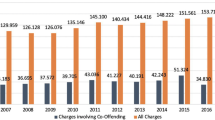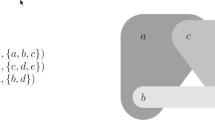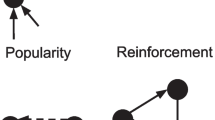Abstract
Co-offending is a common phenomenon in criminology. In previous years, countless studies have contributed to describing the co-offending cooperator's selection process. It has been established that personal characteristics such as age, sex, social/economic status, social/spatial distance, and so on play important roles in co-offender group formation; however, the geographic background of members of the co-offending groups has not received much attention. This study analyzes the assumption that the offender's hometown's homophily enhances co-offending generation and that the size of the offender population of the same hometown (OPSH) would positively impact co-offending formation. To test this, two types of co-offending connections, cross-hometown co-offending (CHCO) and homophily-hometown co-offending (HHCO), are defined respectively, and residential burglary reporting data from Beijing Police from 2005 to 2014 are utilized to investigate the relationship between co-offenders from their hometown backgrounds. The results indicate that HHCO cooperation is more likely to be generated for those who come from large OPSHs, while conversely a large proportion of CHCO cooperation is generated for smaller OPSHs. Additionally, large OPSHs have diverse co-offending connections and attract more partners from the smaller OPSHs, suggesting their more centralized role in co-offending networks.











Similar content being viewed by others
Notes
The data for analysis in this article span from 2005 to 2014; the resolution rate for residential burglary is about 30.5%
Egonet is a kind of method to describe a node and its neighboring vertexes in network; hence, it is the sub-structure of the whole network. The egonet has two most important levels, (1) a star egonet and (2) the first-order egonet. A star egonet is composed of the only ego and his or her alters and is therefore always a star in topology. A first-order egonet is composed of ego and alters and the connections between the alters. By extracting and analyzing the egonet of a targeted node, a clear and detailed understanding of the external connection structure of the ego and the influence of network structure on the actions of the ego could be detected. The measurement of egonet generally includes the size of egonet, type of relationship, density of the network, pattern of relationship, homogeneity, and heterogeneity of network members, etc.
References
Andresen, M.A., and M. Felson. 2012. Co-offending and the diversification of crime types. International Journal of Offender Therapy and Comparative Criminology 56 (5): 811–829.
Arnaboldi, V., Conti, M., Passarella, A., et al. 2012. Analysis of ego network structure in online social networks. International Conference on Privacy, Security and Trust & International Conference on Social Computing. Amsterdam Sep 3–5, IEEE publisher
Becker, S., and J.A. Mccorkel. 2011. The gender of criminal opportunity: The impact of male co-offenders on women’s crime. Feminist Criminology 6 (2): 79–110.
Carrington, P.J. 2009. Co-offending and the development of the delinquent career. Criminology 47 (4): 1295–1330.
Carrington, P.J. 2015. The structure of age homophily in co-offending groups. Journal of Contemporary Criminal Justice 31 (3): 337–353.
Charette, Y., and Papachristos, A.V. 2017. The network dynamics of co-offending careers. Social Networks: S0378873316302234.
Chen, J.G., L. Liu, S.H. Zhou, et al. 2017. Spatial variation relationship between floating population and residential burglary: A case study from ZG China. ISPRS International Journal of Geo-information 6 (8): 16.
Chen, P., and J. Kurland. 2020. The impact of “strike hard” on repeat and near-repeat residential burglary in Beijing. ISPRS International Journal of Geo-Information 9 (3): 18.
Chen, P., and Y. Lu. 2018. Exploring co-offending networks by considering geographic background: An investigation of electric bicycle thefts in Beijing. Professional Geographer 70: 73–83.
D’’Alessio, S.J., and L. Stolzenberg. 2010. Do cities influence co-offending? Journal of Criminal Justice 38 (4): 711–719.
Englefield, A., and B. Ariel. 2017. Searching for influential actors in co-offending networks: the recruiter. International Journal of Social Science Studies 5 (5): 24.
Farrington, D.P. 1992. Criminal career research: Lessons for crime prevention. Studies on Crime & Crime Prevention 1 (1): 7–29.
Felson, M., and L.E. Cohen. 1980. Human ecology and crime: A routine activity approach. Human Ecology 8 (4): 389–406.
Fisher, D. 2005. Using egocentric networks to understand communication. IEEE Internet Computing 9 (5): 20–28.
Freeman, L.C. 1978. Centrality in social networks conceptual clarification. Social Networks 1 (3): 215–239.
Goodkind, D., and L. West. 2002. China’s floating population: Definitions, data and recent findings. Urban Studies 39 (12): 2237–2250.
Grund, T.U., and J.A. Densley. 2015. Ethnic homophily and triad closure: Mapping internal gang structure using exponential random graph models. Journal of Contemporary Criminal Justice 31 (3): 354–370.
Hambly, O. 2017. Investigating domestic burglary: offence, offenders and co-offending. Doctor thesis, University of Huddersfield.
Kwong, J. 2011. Education identity: The marginalisation of migrant youths in Beijing. Journal of youth study 14 (8): 871–883.
Lantz, B. 2018. The consequences of crime in company: Co-offending, victim–offender relationship, and quality of violence. Journal of Interpersonal Violence: https://doi.org/10.1177/0886260518786497.
Li, S.D., and J.H. Liu. 2017. Network characteristics and organizational structure of chinese drug trafficking groups. Asian Journal of Criminology 12 (1): 63–79.
Lin, Y., B.D. Meulder, X. Cai, et al. 2014. Linking social housing provision for rural migrants with the redevelopment of ‘villages in the city’: A case study of Beijing. Cites 40: 111–119.
Matthews, J.L., and T. Matlock. 2011. Understanding the link between spatial distance and social distance. Social Psychology 42 (3): 185–192.
McGloin, J.M., C.J. Sullivan, A.R. Piquero, et al. 2008. Investigating the stability of co-offending and co-offenders among a sample of youthful offenders. Criminology 46 (1): 155–188.
Newman, M.E.J. 2002. Assortative mixing in networks. Physical Review Letters 89 (20): 4.
Nooy, W.D., A. Mrvar, and V. Batagelj. 2005. Exploratory social network analysis with Pajek. New York: Cambridge University Press.
Pettersson, T. 2005. Gendering delinquent networks: A gendered analysis of violent crimes and the structure of boys’ and girls’ co-offending networks. Young 13 (3): 247–267.
Reiss, A.J. 1988. Co-offending and criminal careers. In Crime and justice, ed. Michael H. Tonry and Norval Morris. Chicago, IL: University of Chicago Press.
Schaefer, D.R. 2012. Youth co-offending networks: An investigation of social and spatial effects. Social Networks 34 (1): 141–149.
Tillyer, M.S., and R. Tillyer. 2015. Maybe I should do this alone: A comparison of solo and co-offending robbery outcomes. Justice Quarterly 32 (6): 1064–1088.
Van Mastrigt, S.B., and D.P. Farrington. 2009. Co-offending, age, gender and crime type: Implications for criminal justice policy. British Journal of Criminology 49 (4): 552–573.
Weerman, F.M. 2003. Co-offending as social exchange: Explaining characteristics of co-offending. British Journal of Criminology 43 (2): 398–416.
Xiao, L., L. Liu, G. Song, et al. 2017. Impacts of community environment on residential burglary based on rational choice theory. Geographical Research 36 (2): 2479–2491.
Yue, H., X.Y. Zhu, X.Y. Ye, et al. 2018. Modelling the effects of street permeability on burglary in Wuhan, China. Applied Geography 98: 177–183.
Acknowledgements
This work was supported by MOE (Ministry of Education in China) Project of Humanities and Social Sciences (Project No.20YJAZH009) and Beijing Natural Science Foundation (9192022). Also, it is grateful to the sponsorship from foundation of National Engineering Lab for Social Safety Perception and Prevention in Big Data Application.
Author information
Authors and Affiliations
Contributions
GZ contributed co-offending modeling and data analysis, and PC contributed draft composition and research design.
Corresponding author
Ethics declarations
Conflict of interest
The authors declare that they have no conflicts of interest.
Research involving human participants and/or animals
This study reports on the analyses of co-offending associated with offenders’ hometown information. The related data are secondary data. No identifiable information was accessed nor used by the researchers. Strict privacy protection and ethic procedures were followed with Beijing Municipal Public Security Bureau (BMPSB) for the researchers to access the crime data.
Informed consent
No primary data were collected for this study. Informed consent concern does not apply.
Additional information
Publisher's Note
Springer Nature remains neutral with regard to jurisdictional claims in published maps and institutional affiliations.
Appendix
Appendix
-
(1)
The definition of Direct centrality is:
$${C}_{d}\left(u\right)=\sum_{v=1}^{n}r(v,u)$$(A1)where r(v,u) is a binary variable indicating whether there is the connection between nodes u and v; n represents the total number of nodes in the network. The larger the degree centrality of a given node being, the more neighbors the node has in the network, therefore, the node plays more central role in the network and has more impacting.
-
(2)
The Betweenness centrality of node i in a network G is:
$${C}_{b}\left(i\right)={\sum }_{s,t}\frac{{n}_{s,t}^{i}}{{n}_{s,t}}$$(A2)where s and t represent any pair of nodes in the network except node i; ns,t is the total number of geodesics from s to t; and nis,t indicates the number of the shortest paths between nodes s and t which pass through node i. The greater the BC of a given node, the more it can play the role of information intermediary and plays the central role in the network.
-
(3)
The Closeness centrality of node k in network G is expressed as follows:
$${C}_{c}\left(k\right)=\frac{n-1}{{\sum }_{j}{d}_{j}}$$(A3)where dj is the distance between nodes j and k, and n is the total number of the nodes in the network G. The greater the CC of a node, the closer the node is to other nodes and the easier it is to transmit network information and resource, so it is more likely to be in the center of the network.
-
(4)
The formulation of network assortativity is:
$${f}_{nn,i}=\frac{1}{{C}_{i}}\sum_{j\epsilon u(i)}{f}_{j}$$(A4)where fnn,i is the average feature value of all adjacent nodes of node i; u(i) represents the set of adjacent nodes of node i; ci represent the degree of node i. The correlation level between the feature fi of each node and fnn,i reflects assortativity of the network, which reflects the connection preference among nodes.
Rights and permissions
About this article
Cite this article
Zhu, G., Chen, P. Investigating co-offender connections from offender’s hometown background: a practical study in Beijing. Secur J 35, 549–570 (2022). https://doi.org/10.1057/s41284-021-00290-6
Accepted:
Published:
Issue Date:
DOI: https://doi.org/10.1057/s41284-021-00290-6




